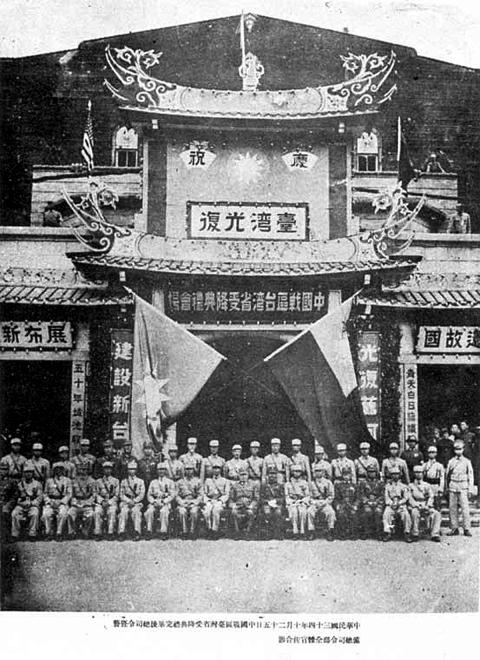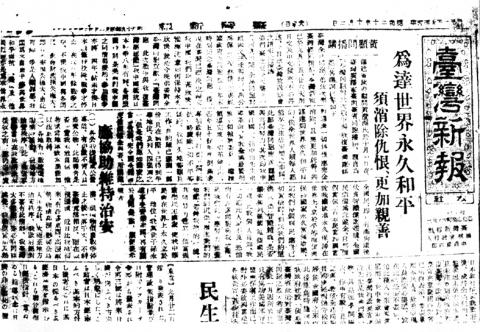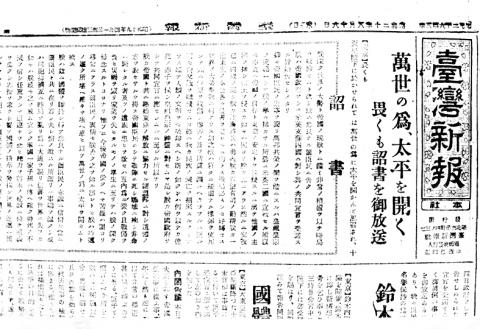Emperor Hirohito’s voice could be heard through radios across the Japanese Empire that day, including Taiwan. Not everyone had radios back then, but those who did didn’t hesitate to spread the news. It was Aug. 15, 1945, and Japan had officially announced its surrender to the Allies.
A much contested outcome of the Cairo Declaration of 1943 is that Taiwan, which Qing Dynasty China ceded to Japan in the treaty of Shimonoseki following its defeat in the First Sino-Japanese War, would return to China, then ruled by the Chinese Nationalist Party (KMT).
Although KMT leader Chiang Kai-shek (蔣介石) appointed Chen Yi (陳儀) as governor general of Taiwan on Aug. 29, Chen didn’t land until Oct. 24. The next day, he formally accepted the Japanese governor-general’s surrender.

Photo courtesy of Wikipedia Commons
While the KMT was busy planning its arrival, what was going on in Taiwan between Aug. 15 and Oct. 25?
AFTER THE SURRENDER
The Taiwanese attitude toward the newcomers varies depending on who you ask, and will not be discussed here. Most sources agree, though, that the majority of people were more than happy to see the Japanese go.

Photos: Han Cheung,Taipei Times
Sources point to a short-lived Taiwanese independence attempt right after the surrender was announced, where Japanese military officers allegedly plotted with prominent Taiwanese to resist the Chinese takeover, though the level of Taiwanese involvement is disputed. This plan was abandoned just a week later after governor-general Ando Rikishi publicly warned against any such actions.
Historian and author Tseng Chien-min (曾建民) writes in 1945: Taiwan at Daybreak (1945: 破曉時候的台灣) that at least for the first 20 days, all Japanese colonial government activities went on as usual, as if nothing had changed. Tseng says that it was the Japanese police and members of the Japan-friendly volunteer fighting corps who kept social order during that time.
Because of that, Tseng says that Taiwanese were wary of celebrating openly at first, only doing so after the surrender was formally signed on Sept. 2.

Photo: Han Cheung,Taipei Times
Tseng says that as Japanese power waned, social order fell into the hands of local groups such as the Three Principles Youth Group (三民主義青年團).
According to History of Taiwan under Japanese Rule by Suemitsu Kazuya, on Sept. 1, 18 US and Chinese soldiers and officials arrived to liberate surviving Allied prisoners of war. More US troops landed for the same purpose on Sept. 5 and Sept. 7.
On Sept. 14, staff with the Taiwan Takeover Preparation Committee (台灣接收準備委員會) landed, making contact with the remaining Japanese military. Between Sept. 20 and Sept. 26, between 200 and 300 KMT troops occupied airports in Taipei, Taichung, Chiayi and Pingtung.
Taiwan’s only newspaper at that time, the Japanese-language Taiwan Shin Pao (台灣新報) published its first Chinese article on Oct. 2. By Oct. 10, Chinese had become the paper’s main language.
The entirely Chinese Min Pao (民報) was established on Oct. 10, and was known for being progressive and outspoken.
Committees to welcome the new government sprung up in various cities, making and delivering Republic of China (ROC) flags to offices and schools, putting up patriotic banners and teaching locals to speak Mandarin. According to a Min Pao article, almost 4,000 people showed up to a Mandarin class on Oct. 21.
What many call the “government-less” period lasted until Oct. 6, when the Taiwan Garrison Command’s (台灣警備總司令部) forward command (前進指揮所) arrived. It immediately issued several orders, including that administrative and legal functions were to still be carried out by the Japanese governor-general’s office until Chen Yi’s arrival and that all public functions such as traffic and mail should remain operating as usual. Education was to continue as before, with the exception that anything that challenged the ROC’s “status or educational philosophy” should be deleted.
Taiwanese observed Double Ten National Day for the first time with a huge celebration at the Taipei Public Assembly Hall, which is now Zhongshan Hall (中山堂).
More troops continued to arrive in Taiwan over the following few weeks, and spirits remained high, paving the way for Chen Yi’s big day. What happened in the next few years is another story.
OTHER EVENTS THIS WEEK IN HISTORY
Construction on the Sun Yat-sen Freeway began on Aug. 14, 1971, taking seven years to complete. Two oft-visited spots in the country opened to the public on Aug. 10, 1979: Leofoo Village Safari Park (六福村野生動物園) and Provincial Highway 2, better known as North Coastal Highway (北部濱海公路).

Last week saw the appearance of another odious screed full of lies from the People’s Republic of China (PRC) Ambassador to Australia, Xiao Qian (肖千), in the Financial Review, a major Australian paper. Xiao’s piece was presented without challenge or caveat. His “Seven truths on why Taiwan always will be China’s” presented a “greatest hits” of the litany of PRC falsehoods. This includes: Taiwan’s indigenous peoples were descended from the people of China 30,000 years ago; a “Chinese” imperial government administrated Taiwan in the 14th century; Koxinga, also known as Cheng Cheng-kung (鄭成功), “recovered” Taiwan for China; the Qing owned

In Taiwan’s politics the party chair is an extremely influential position. Typically this person is the presumed presidential candidate or serving president. In the last presidential election, two of the three candidates were also leaders of their party. Only one party chair race had been planned for this year, but with the Jan. 1 resignation by the currently indicted Ko Wen-je (柯文哲) of the Taiwan People’s Party (TPP) two parties are now in play. If a challenger to acting Chairman Huang Kuo-chang (黃國昌) appears we will examine that race in more depth. Currently their election is set for Feb. 15. EXTREMELY

Jan. 20 to Jan. 26 Taipei was in a jubilant, patriotic mood on the morning of Jan. 25, 1954. Flags hung outside shops and residences, people chanted anti-communist slogans and rousing music blared from loudspeakers. The occasion was the arrival of about 14,000 Chinese prisoners from the Korean War, who had elected to head to Taiwan instead of being repatriated to China. The majority landed in Keelung over three days and were paraded through the capital to great fanfare. Air Force planes dropped colorful flyers, one of which read, “You’re back, you’re finally back. You finally overcame the evil communist bandits and

They increasingly own everything from access to space to how we get news on Earth and now outgoing President Joe Biden warns America’s new breed of Donald Trump-allied oligarchs could gobble up US democracy itself. Biden used his farewell speech to the nation to deliver a shockingly dark message: that a nation which has always revered its entrepreneurs may now be at their mercy. “An oligarchy is taking shape in America of extreme wealth, power and influence that literally threatens our entire democracy, our basic rights and freedoms,” Biden said. He named no names, but his targets were clear: men like Elon Musk